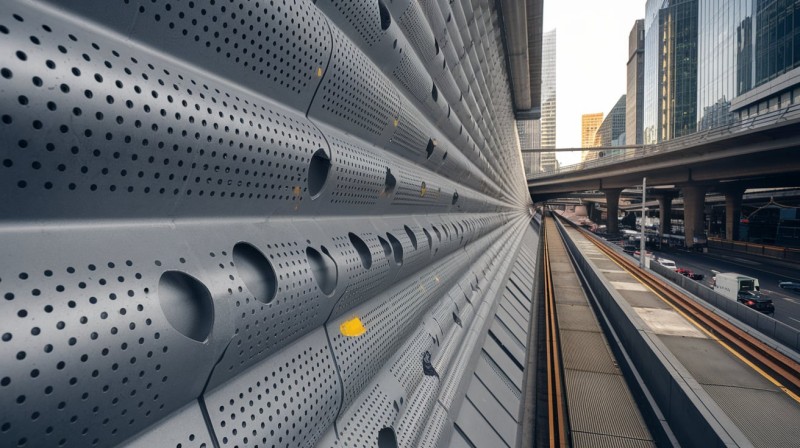Using Perforated Metal in Sound Barrier Walls for Urban Noise Reduction
In today’s growing urban environments, noise pollution has become a significant concern for city planners and residents alike. Perforated metal sound barriers have emerged as an innovative and effective solution for managing urban noise, particularly in high-traffic areas. Let’s explore how these sophisticated barriers are reshaping urban acoustics.
Acoustic Performance Benefits
Noise Reduction Capabilities
●Up to 20-25 dB noise reduction
●Frequency-specific attenuation
●Variable acoustic absorption
●Customizable sound control
Design Advantages
1. Sound Wave ManagementMultiple reflection patterns
a. Acoustic energy absorption
b. Frequency diffusion
c. Sound wave interference
2. Performance FactorsPerforation pattern impact
a. Material thickness effects
b. Air gap optimization
c. Surface treatment influence
Technical Specifications
Material Properties
●Aluminum for lightweight applications
●Galvanized steel for durability
●Stainless steel for premium locations
●Powder-coated finishes for aesthetics
Design Parameters
●Perforation sizes: 1mm to 20mm
●Open area: 20% to 60%
●Panel thickness: 1mm to 5mm
●Custom patterns available
Urban Applications
Highway Noise Barriers
●Interstate sound walls
●Urban freeway barriers
●Bridge approach barriers
●Tunnel entrance shields
Urban Infrastructure
●Railway line protection
●Industrial zone buffering
●Construction site screening
●Entertainment district sound control
Case Studies
Highway Project Success
A major urban highway reduced nearby residential noise levels by 22dB using customized perforated metal barriers, significantly improving quality of life for residents.
Railway Line Achievement
An urban rail system decreased noise pollution by 18dB in residential areas through strategic placement of perforated metal sound barriers.
Installation and Integration
Structural Considerations
●Foundation requirements
●Wind load resistance
●Seismic considerations
●Drainage integration
Assembly Methods
●Modular installation
●Panel connection systems
●Support structure integration
●Maintenance access
Environmental Benefits
Sustainability Features
●Recyclable materials
●Low maintenance requirements
●Long service life
●Energy-efficient production
Additional Advantages
●Natural ventilation
●Light transmission
●Wildlife protection
●Visual aesthetics
Cost-Effectiveness
Long-term Benefits
●Minimal maintenance needs
●Extended service life
●Property value protection
●Community health benefits
Installation Efficiency
●Rapid deployment
●Modular construction
●Minimal disruption
●Scalable solutions
Aesthetic Integration
Design Flexibility
●Custom perforation patterns
●Color options
●Texture variations
●Artistic possibilities
Urban Design Compatibility
●Modern architectural integration
●Cultural context consideration
●Landscape harmonization
●Visual impact management
Performance Monitoring
Acoustic Testing
●Sound level measurements
●Frequency analysis
●Performance verification
●Regular monitoring
Maintenance Requirements
●Periodic inspections
●Cleaning procedures
●Repair protocols
●Replacement planning
Future Developments
Innovation Trends
●Smart material integration
●Advanced acoustic design
●Sustainable materials
●Enhanced durability
Research Directions
●Improved noise reduction
●Better aesthetic options
●Reduced costs
●Enhanced sustainability
Conclusion
Perforated metal sound barriers represent a perfect blend of function and form in urban noise management. Their ability to effectively reduce noise while maintaining aesthetic appeal makes them an ideal choice for modern urban environments.
